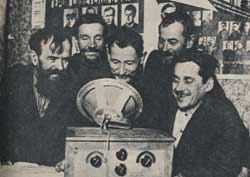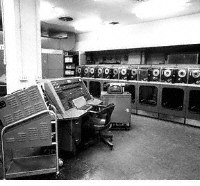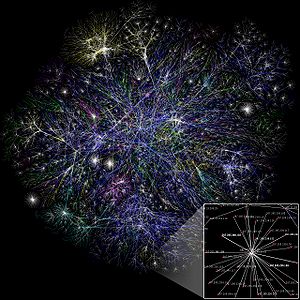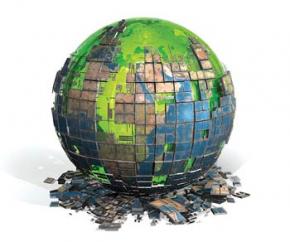E-learning concepts - Table of Content
TOC of Lecture notes, readings, exercises
E-learning
and ICT
 Learning Objectives
Learning Objectives
When you have completed this session, you should be able to
- describe the different stages of e-learning’s technical evolution,
- identify the effects of ‘technological convergence’ in your own teaching practice.
 Reading
Reading
The generation born after 1980 is sometimes called the net generation – the digital natives. They are the first generation to become adults in the information society. They know the underpinning technology of the information society in an almost sub-conscious way.
What does ICT mean?
The acronym is made of the initials of "information and communication technology" or, more simply, info-communication technology. What is behind the evolution of this concept?
Technological convergence, globalization
Sociologists have termed the 20th century the age of technological convergence and globalization. Earlier analogue technology was gradually replaced by an era based on digital technology. Digital video and television have appeared in recent years, for example, and analogue telephone lines have been slowly replaced by digital solutions. [2]
Due to digitization the industrial sectors of:
• computer technology and computerized networks,
• telecommunication (telephone, fax), and
• audiovisual appliances (TV, radio, entertaining appliances).
are gradually merging.
This is called technological convergence . Mobile phones can be used for taking pictures, listening to music. With small communications devices we can connect to the Internet, and via Internet we can watch TV, listen to the radio and phone…
The development of communication technology
|
Computers with the Neumann-principles (1940-1955)
|
Second and third generation computers (1960-1980)
The fourth generation computer system was made possible by the application of VLSI (Very Large Scale Integration). In 1971, INTEL created the first micro-processor: a few thousand active circuit units executing all the essential functions in one chip. In 1981 IBM presented the PC (Personal Computer) based on the Intel 8088. |
The improvement of storage capacity
|
The development of input and output peripheriesIn the 90s the mouse appeared as an input tool. It seems to be insignificant but in fact, when considering the everyday work done by computers, it was a very significant change. The first impact printers were followed by high-speed laser printers and multi-function office equipments. Cathode ray monochrome monitors were replaced by low TFT monitors. |
Computer networks
|
Multimedia
Nowadays we live in a new communication age with its enabling technology being wireless technology. Mobile phones have become universally adopted at a speed never experienced before. A new concept has become possible for the next generation of e-learning – ‘m-learning’ or ‘mobile learning’. This is education delivered through mobile technology. [3] The information society is a world model of ‘globally’ based knowledge. It accesses the whole the history of human civilization and culture. It came into being, and expanded from, the end of the 20th century [2]. Its development, however, started in the 60s and 70s. The information society sits on an economy based on know-how, where information has become an asset. High quality technical investments and constantly upgraded information technology requires “lifelong learning” for the citizens of this society and so the problem of renewing our educational systems comes sharply into focus. |
 Exercises
Exercises
1. Design a survey for your fellow students. The survey is to determine when they first came across the terms “technological convergence" and "net generation". Write a report on the results of your survey in your learning diary.
2. Write a report entitled “The effects on education of Globalization” in your learning diary.
References:
1. Information Society, edited by Robert Pintér, Gondolat, Bp. 2008. http://netis.nyme.hu/
2. Communication World Report, 1997 ORTT, Magyar UNESCO Bizottság, Bp. 1988.
3. Desmond Keegan: Mobile Learning: the next generation of e-learning, Distance Educational Institute, 2005.
 Communication between people was revolutionized by the innovations of late 19th and early 20th century such as the telegraph, telephone, radio, and television. The foundation for these innovations was provided by scientific results in the area of magnetic science and electricity.
Communication between people was revolutionized by the innovations of late 19th and early 20th century such as the telegraph, telephone, radio, and television. The foundation for these innovations was provided by scientific results in the area of magnetic science and electricity. The principles of the logical structure of electronic computer appliances by János Neumann (1903–1957), Goldstein and Burks was published in 1946. The first stored program-controlled computer – the UNIVAC (1951) – was built according to their ideas, and was created for market sale, not a specific need.
The principles of the logical structure of electronic computer appliances by János Neumann (1903–1957), Goldstein and Burks was published in 1946. The first stored program-controlled computer – the UNIVAC (1951) – was built according to their ideas, and was created for market sale, not a specific need. The first transistor was invented at Bell Laboratories in 1947. With the application of transistors and ferric rings the so called second generation computers were created with a much smaller size and remarkably less heating problems as their predecessors, while at the same time being much faster and with a storage capacity improved by magnitudes.
The first transistor was invented at Bell Laboratories in 1947. With the application of transistors and ferric rings the so called second generation computers were created with a much smaller size and remarkably less heating problems as their predecessors, while at the same time being much faster and with a storage capacity improved by magnitudes.  The immense ‘info-communication leap’ was the development of computer networks in the 70s.
The immense ‘info-communication leap’ was the development of computer networks in the 70s. The hardware support that makes it possible to send, read, listen to digitized multimedia information (images, video, audio) to/from any part of the world quickly and with high quality relies on multimedia technologies.
The hardware support that makes it possible to send, read, listen to digitized multimedia information (images, video, audio) to/from any part of the world quickly and with high quality relies on multimedia technologies.